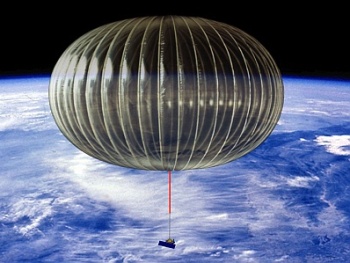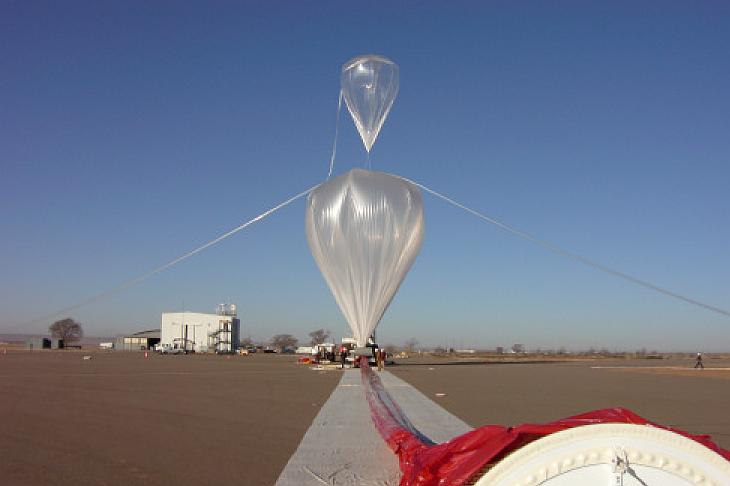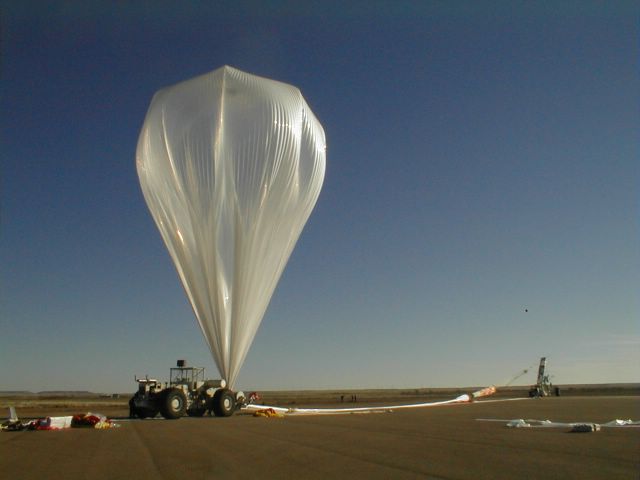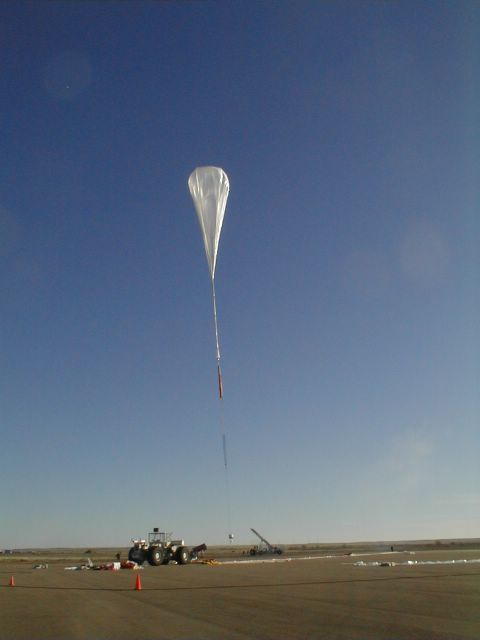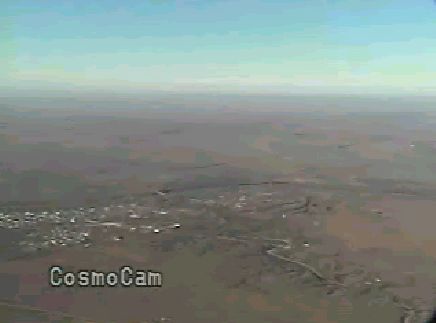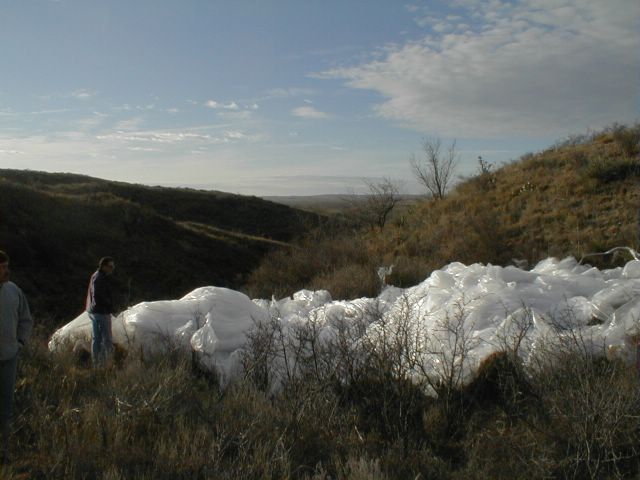Purpose of the flight and payload description
A project to develope a balloon system capable of providing scientific measurements for 100-day missions with floating altitude close to 35km transporting payloads of near 1.5 tons.
It is a super-pressure balloon made of a composite fabric (polyester + polyethylene film and fabric) that is filled with Helium and hermetically sealed. Meridional tendons provide additional rigidity to the envelope. The pressure inside the envelop is maintained above the ambient pressure at all times to keep the balloon afloat at a constant altitude. During daytime the internal pressure increases due to solar heating but the volume remains constant due to the rigidity of the envelope. At night the pressure drops due to infrared radiative cooling to space, but as long as the internal pressure remains above the ambient pressure, the balloon stays at the same altitude.
On the future, transported by stratospheric winds around the globe at 30m/s the ULDB would be make a full circunnavegation to Earth in about 2 weeks.
Details of the balloon flight
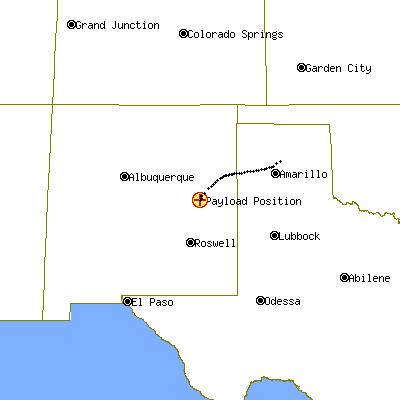
Balloon launched on: 2/4/2005 at 15:56 utc
Launch site: Scientific Flight Balloon Facility, Fort Sumner, (NM), US
Balloon launched by: National Scientific Balloon Facility (NSBF)
Balloon manufacturer/size/composition: Ultra Long Duration Balloon Main: Raven - 176.000 m3 (1.5 mil) - Tow 300 m3 ( - SF4-6.206-1.5/.8N
Balloon serial number: R6.21-1.5U1-01
Flight identification number: 540N
End of flight (L for landing time, W for last contact, otherwise termination time): 2/4/2005 at 18:53 utc
Balloon flight duration (F: time at float only, otherwise total flight time in d:days / h:hours or m:minutes - ): 2 h 43 m
Landing site: 20 miles NE of Amarillo, Texas, US
Payload weight: 770 lbs
Overall weight: 3000 lbs
The launch by dynamic method using launch vehicle and with an auxiliary balloon on top of the main to help to deploy the balloon envelope, was complished at 15:56 utc on febraury 4th, 2005.
The balloon release took place without incident and the payload was released normally. The balloon ascended at a rate of 4-6 m/s during the initial part of the ascent. The flight plan called for entering float altitude at a very low ascent rate to allow for a gentle pressurization after reaching float altitude. The helium valves were opened at an altitude of 18.3 km to slow the ascent rate from 3 m/s to 1.5 m/s.
This system of opening the valves when the ascent rate exceeded 3 m/s and closing them when the ascent rate fell below 1.5 m/s worked very well. The valves were closed in manual mode at an altitude of 26.6 km. At that time, they were put in automatic mode. They were set to open when the differential pressure inside the balloon reached 50 Pa.
With the valving during ascent, the balloon reached float altitude of 30.5 km in 2.7 hours heading northeast, (click in the map at left to see the balloon flight path).
After near 3 hours of stable flight over New Mexico and north Texas, at 18:53 utc the cutdown command was sent. The payload touched ground at 19:30 utc 20 miles NE of Amarillo, Texas, at coordinates 35-35.94 N / 101-34.52 W. The payload and balloon were recovered in good shape and returned to the Ft. Sumner facility the next day.
After several failures in past test flight and a deep investigation, the older design proved to be faulty so a new approach was intended. This was a test flight of a 6.000.000 cubic feet ULDB vehicle, a scaled structure of the new design.
The general objectives were to fully deploy the structure under low pressure and then incrementally increase the pressure inside the balloon to the maximum extent possible via dropping ballast or until failure.
After a normal launch and a carefully carried ascent phase (contoled by valving and ballasting the balloon), it reached the float altitude of 30.5 km, and began pressurizing. The shell was completely deployed in the upper section of the balloon with only two small areas remaining to be opened up. These two areas were completing their deployment as the balloon was pressurizing.
As the balloon reached 55 Pa differential pressure, the bottom 10 meters of the closing seal in the balloon came open. It was easy to identify the seal that failed because an on-board camera captured the failure as it happened.
The flight was terminated shortly after the failure occurred. After recovery the balloon was carefully examined concluding that the bottom 10 meters of the balloon's closing seal was found to have peeled open. This is highly unusual since specific steps are taken in the production plant to prevent this from happening. A thorough investigation was undertaken with NASA, Aerostar, and PSL participating until the final conclusion: the balloon material in the first gore in these areas was closely tested and was found to be oxidized by the lighting in the production plant. During the production of a ULDB, the first gore of the balloon will remain on the table for two months. During this time, it is exposed to the plant lighting during the first and last ten meters of the balloon. The center section of the balloon is covered by the other gores and is not exposed to plant lighting.
External references
- ULDB website - Balloon Programe Office NASA Wallops flight facility
- Development of the NASA Ultra-Long Duration Balloon 2007 NASA Science Technology Conference - University of Maryland
- Test Flights of the Revised ULDB Design AIAA-ATIO conference, October 2005, Crystal City, VA, USA
- Ultra Long Duration Balloon Test Flight Inside Wallops - Volume XX-05 Nº 05
697If you consider this website interesting or useful, you can help me to keep it up and running with a small donation to cover the operational costs. Just the equivalent of the price of a cup of coffee helps a lot.

